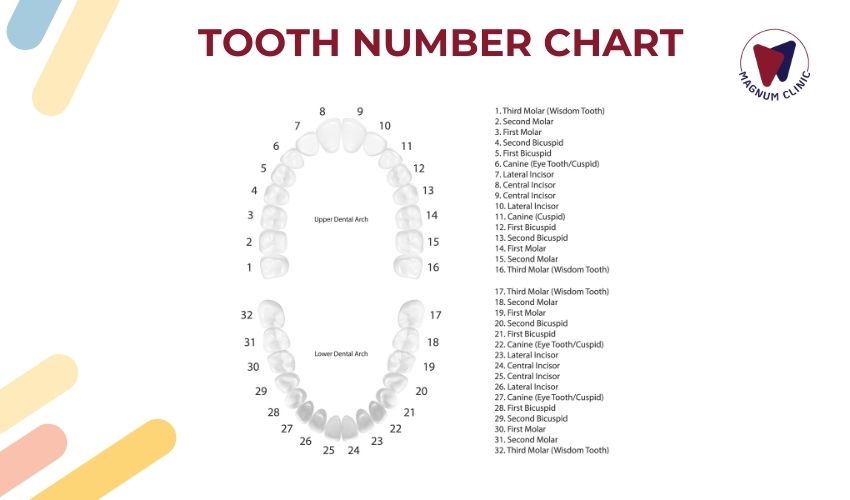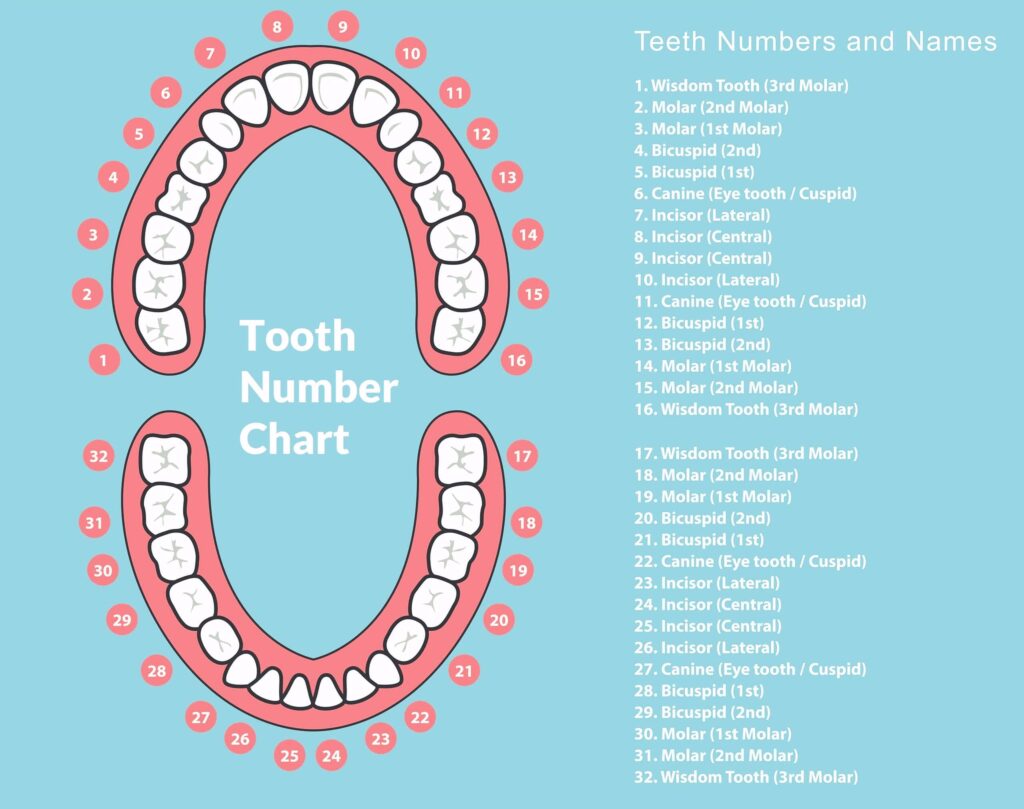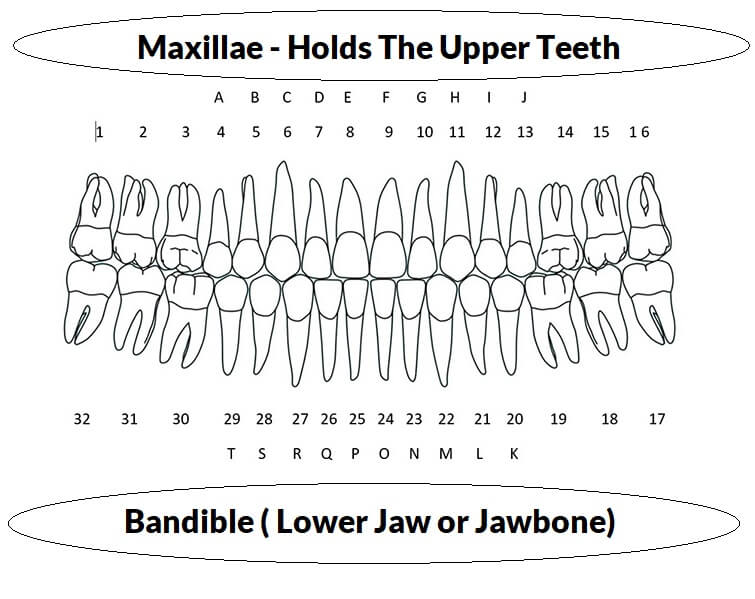Tooth Numbers and Name Chart for Adults and Children: Understanding Tooth Structure and Common Dental Issues

Tooth Chart - Introduction
We use our teeth every day to bite, chew, and speak. But how much do we know about the structure of our teeth and the dental issues that can affect them? Understanding the anatomy of teeth can help us take better care of our oral health and prevent common dental problems. This article will provide an overview of the tooth structure and a Tooth chart for adults and children. Additionally, we will discuss common dental issues and how to take care of our teeth to prevent them.
What Is A Tooth Number Chart?
Dentists and other dental professionals use tooth number charts to identify and refer to specific teeth in the mouth. It typically depicts a human mouth, with each tooth identified by a specific number or letter.
Each tooth is given a number from 1 to 32, starting with the upper right third molar (tooth number 1) and ending with the lower right third molar (tooth number 32) by the Universal Numbering System, which is the most widely used system. A teething chart is essential for dental diagnosis, treatment planning, and record-keeping.
Tooth Chart for Adults and Children

A Tooth chart is a dental diagram showing the numbers and names of teeth in adults and children. This permanent teeth chart is helpful for dentists, orthodontists, and patients to communicate about specific teeth and dental issues. The following is a teeth names chart for adults and children:
Adult teeth chart and Arrangement
| Upper Teeth | Lower Teeth |
| 1. Central Incisor | 1. Central Incisor |
| 2. Lateral Incisor | 2. Lateral Incisor |
| 3. Canine | 3. Canine |
| 4. First Premolar (Bicuspid) | 4. First Premolar (Bicuspid) |
| 5. Second Premolar (Bicuspid) | 5. Second Premolar (Bicuspid) |
| 6. First Molar | 6. First Molar |
| 7. Second Molar | 7. Second Molar |
| 8. Third Molar (Wisdom Tooth) | 8. Third Molar (Wisdom Tooth) |
Children's Teeth Chat and Arrangement
| Upper Teeth | Lower Teeth |
| 1. Central Incisor | 1. Central Incisor |
| 2. Lateral Incisor | 2. Lateral Incisor |
| 3. Canine | 3. Canine |
| 4. First Molar | 4. First Molar |
| 5. Second Molar | 5. Second Molar |
Permanent teeth eruption chart
A permanent teeth eruption chart visually represents when permanent teeth should emerge in the mouth. The 32 permanent teeth are normally shown on the Tooth chart from the first molars to the wisdom teeth in the order of predicted eruption. Additionally, it could detail any variations or outliers from the norm and the typical ages at which each tooth erupts. This tooth chart can be helpful for parents, dentists, and orthodontists to monitor a child's dental development and see any potential problems that could need attention.
Primary teeth eruption chart
A primary teeth eruption chart, often called a baby teeth eruption chart, is a visual aid that illustrates the sequence and general age range of when children's baby teeth generally erupt and fall out.
The tooth chart contains the 20 primary teeth, also known as milk or deciduous teeth, and is frequently used by parents and pediatric dentists to track a child's dental growth and spot any early problems. The lower front teeth are often listed first on the primary teeth eruption chart, followed by the second molars, in the order that they erupt.
Dental forceps chart
A dental forceps chart is a tool that helps dentists select the best forceps for a particular tooth extraction. All teeth, including primary and permanent, are listed on the chart, along with the appropriate pair of extraction forceps. The tooth chart aids dentists in determining the ideal tooth extraction angle, position, and force, resulting in a quick and painless process.
The dental forceps chart normally contains details about each tooth, including its name, number, and the type of forceps suggested. It is a crucial tool for any dental office, enabling dentists to offer their patients high-quality dental care.
Teeth Shape Chart

Depending on the classification system being utilized, various tooth shape charts exist. The four major tooth kinds are incisors, canines, premolars, and molars, and this classification is frequently used. Here is a brief description of each type of tooth's appearance and purpose:
- The upper and lower jaw's front teeth, or incisors, have a flat, sharp edge for cutting and biting food.
- The canines, which are the sharp teeth next to the incisors, are utilized for grabbing and shredding food.
- The premolars are between the canines and the molars, which have two cusps (points) for chopping and grinding food.
- The four-toothed molars are the largest teeth in the back of the mouth.
Chart Number of Root Canals in Teeth
The number of root canals in teeth can vary depending on the tooth's type and location in the mouth. Here is a general overview:
- Incisors and Canines (front teeth): Usually have one root canal each.
- Premolars (bicuspids): Typically have one or two root canals each.
- Molars (back teeth): Can have one, two, three, or even four root canals each.
Teeth Growth Chart
A teeth growth chart is a useful tool for tracking the growth and development of a child's teeth. It can help parents and dentists identify issues or potential problems with a child's oral health and determine the appropriate action. The tooth chart typically shows the order in which the baby teeth emerge and fall out, as well as the expected timeline for the growth of permanent teeth.
Here is a general timeline for the growth of a child's teeth:
- 6 months: The first tooth erupts (usually one of the bottom front teeth)
- 8-12 months: Four front teeth (two on top, two on bottom) have erupted
- 16-20 months: First molars emerge
- 20-30 months: Canine teeth (also known as cuspids) emerge
- 28-32 months: Second molars emerge
- 9-12 years: Baby teeth fall out and are replaced by permanent teeth
- 17-25 years: Wisdom teeth (third molars) emerge (or may not emerge at all)
Teeth Names and Numbers
Details of tooth number with their name. Naming permanent teeth under universal numbering system.
- Tooth Number 1: 3rd Molar commonly known as wisdom tooth
- Tooth Number 2: 2nd Molar
- Tooth Number 3: 1st Molar
- Tooth Number 4: 2nd Bicuspid also known as 2nd premolar
- Tooth Number 5: 1st Bicuspid or 1st premolar
- Tooth Number 6: Cuspid or canine
- Tooth Number 7: Lateral incisor (upper right)
- Tooth Number 8: Central incisor (upper right)
- Tooth Number 9: Central incisor (upper left)
- Tooth Number 10: Lateral incisor (upper left)
- Tooth Number 11: Cuspid (canine/eye tooth)
- Tooth Number 12: 1st Bicuspid or 1st premolar
- Tooth Number 13: 2nd Bicuspid or 2nd premolar
- Tooth Number 14: 1st Molar
- Tooth Number 15: 2nd Molar
- Tooth Number 16: 3rd Molar or wisdom tooth
- Tooth Number 17: 3rd Molar or wisdom tooth (lower left )
- Tooth Number 18: 2nd Molar
- Tooth Number 19: 1st Molar
- Tooth Number 20: 2nd Bicuspid or 2nd premolar
- Tooth Number 21: 1st Bicuspid or 1st premolar
- Tooth Number 22: Cuspid or canine
- Tooth Number 23: Lateral incisor
- Tooth Number 24: Central incisor
- Tooth Number 25: Central incisor
- Tooth Number 26: Lateral incisor
- Tooth Number 27: Cuspid or canine
- Tooth Number 28: 1st Bicuspid or 1st premolar
- Tooth Number 29: 2nd Bicuspid or 2nd premolar
- Tooth Number 30: 1st Molar
- Tooth Number 31: 2nd Molar
- Tooth Number 32: 3rd Molar (lower right wisdom tooth)
Magnum Dental Services
Magnum Dental Services offers various dental services to help you maintain oral health and prevent dental problems. From routine cleanings and checkups to more complex procedures like root canals and dental implants, Magnum Dental Services can help you achieve a healthy, beautiful smile.
Magnum Dental Services can provide expert care and treatment to restore oral health if you are experiencing dental problems related to tooth chart structure, such as cavities or gum disease. And if you are interested in improving the appearance of your teeth, they also offer cosmetic dentistry services like teeth whitening and veneers.
FAQ Related Tooth Chart
1. Why do dentists use tooth charts?
Tooth charts record a patient's specific teeth, any problems with or treatments for those teeth, and monitor a child's tooth development or eruption. They provide dentists with a standardized method of keeping accurate records and communicating information about a patient's teeth to other dental specialists.
2. How can dentists use dental charts?
Dental professionals use tooth charts to note each tooth's location and state and any cavities, fillings, or other treatments. Additionally, they may utilize tooth charts to plan for orthodontic treatment or tooth extractions and monitor the growth and eruption of a child's teeth.
3. Do several kinds of tooth charts exist?
Yes, there are several kinds of tooth charts, such as charts for the eruption of the primary and permanent teeth, forceps charts, and charts for the shape of the teeth. A certain sort of chart will be employed depending on the precise information required for the dental surgery or treatment.
4. Do patients have access to their dental records?
Patients typically have access to their dental files, including tooth charts. A copy of the patient's records, which could include x-rays, treatment notes, and tooth charts, can be requested from the dentist by the patient.
5. Do tooth diagrams evolve?
As teeth are lost, removed, or new teeth sprout, tooth charts may change over time. Dentists must maintain correct records and regularly update tooth charts.
